Welcome to the world of red birds in South Carolina! This beautiful state is home to various red birds, including the Northern Cardinal, the Painted Bunting, and the Red-headed Woodpecker.
These birds and many other species can be found throughout the state, from its coastal beaches to its inland forests.
Whether you are a bird enthusiast or simply looking to appreciate nature, South Carolina is the perfect place to observe and enjoy the colors of these beautiful birds.
21 Red Birds In South Carolina
South Carolina, nestled in the heart of the southeastern United States, boasts a rich tapestry of biodiversity, with its marshlands, forests, and coastal plains serving as havens for a plethora of wildlife.
Here are 21 red birds you can find in South Carolina, along with some interesting facts about each of them:
1. House Finch
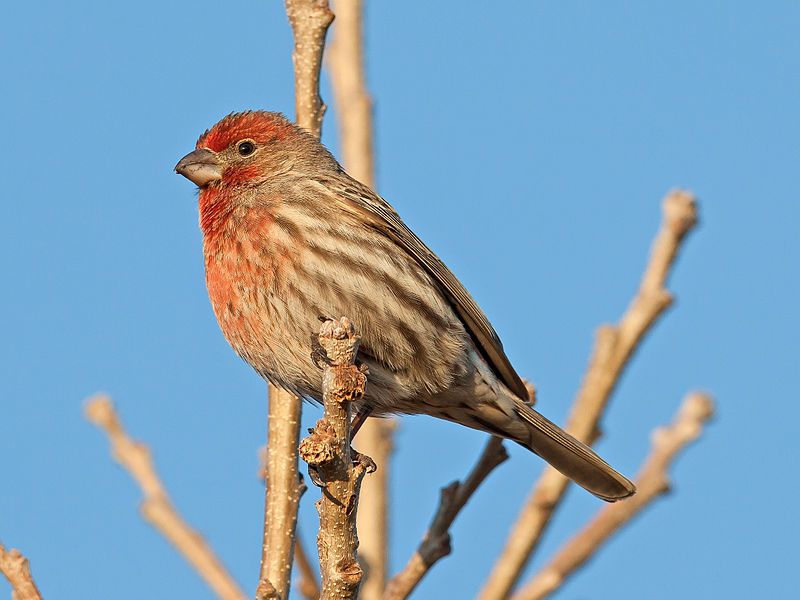
The house finch is a species of bird in the family Fringillidae, which also includes other finch species. It is native to western North America but has been introduced to the eastern half of the continent and Hawaii.
The house finch belongs to a group of birds called the American rosefinches, all placed in the genus Haemorhous. This genus consists of three species: the house finch, the purple finch, and the cassin’s finch.
All three species share many of the same physical characteristics, such as a red-brown head, a brown back and wings, and a white belly. The house finch is incredibly recognizable by its red markings around the face and neck.
It is a social species, often found in large groups in open areas or near human habitation. The house finch is also a famous cage bird due to its small size, attractive plumage, and cheerful song.
| Kingdom | Animalia |
| Phylum | Chordata |
| Class | Aves |
| Order | Passeriformes |
| Family | Fringillidae |
| Genus | Haemorhous |
| Species | H. mexicanus |
2. Northern Cardinal
The northern cardinal is a type of bird in the genus Cardinalis. It is known by many names, including the redbird, common cardinal, red cardinal, or simply cardinal. It is easily recognizable by its bright red plumage and distinctive crest.
The northern cardinal is found across much of the eastern and central United States and Canada, and its range is gradually expanding outward. It prefers open wooded areas and gardens but can also be spotted in suburban areas.
The northern cardinal is a sociable bird, usually seen in pairs or small groups, and is often seen foraging for seeds and insects on the ground. It is also a famous backyard bird, with its bright colors and melodious song, making it a welcome addition to any garden.
| Kingdom | Animalia |
| Phylum | Chordata |
| Class | Aves |
| Order | Passeriformes |
| Family | Cardinalidae |
| Genus | Cardinalis |
| Species | C. cardinalis |
3. Cardinalidae
Cardinalidae is a family of passerine birds only found in the New World. This family comprises three main genera of birds: cardinals, grosbeaks, and buntings. These genera are all very distinct, having different shapes and sizes.
Cardinals are large birds with a short, thick bill and a distinctive crest. Grosbeaks are larger than cardinals, with a larger bill and a more rounded body.
Buntings are the smallest group, with a finch-like shape and a slender bill. Aside from cardinals, grosbeaks, and buntings, the Cardinalidae family also includes several other genera of birds.
The tanager-like Piranga is similar to a cardinal in shape but with a more slender bill. The warbler-like Granatellus is much smaller than a cardinal, with a slim body and a thin bill.
Each of these genera adds to the diversity of the Cardinalidae family, making it one of the most exciting and diverse of all passerine families.
| Kingdom | Animalia |
| Phylum | Chordata |
| Class | Aves |
| Order | Passeriformes |
| Family | Cardinalidae |
4. Summer Tanager
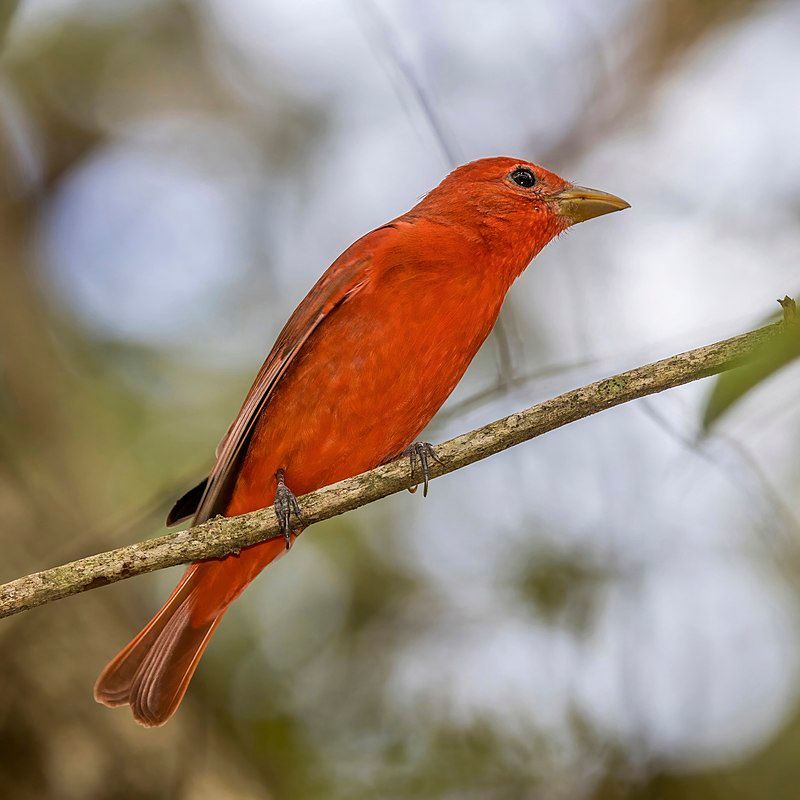
The summer tanager is a medium-sized songbird native to the Americas. It was formerly classified in the Tanager family, but recent research has determined that it and other members of its genus should be placed in the cardinal family.
This is evident in the species’s plumage and vocalizations, which are very similar to other members of the cardinal family. The plumage of the summer tanager can range from yellowish to bright red, and its black wings and tail can identify it.
It is also known for its distinctive call: a short, sharp whistle. This call can often be heard when the bird is most active in the summer. In addition, the summer tanager can be identified by its distinctive song, a series of short, high-pitched notes.
The summer tanager is an integral part of the American avian population, and it is essential to preserve its habitat to ensure its continued survival.
| Kingdom | Animalia |
| Phylum | Chordata |
| Class | Aves |
| Order | Passeriformes |
| Family | Cardinalidae |
| Genus | Piranga |
| Species | P. rubra |
5. Red-Headed Woodpecker
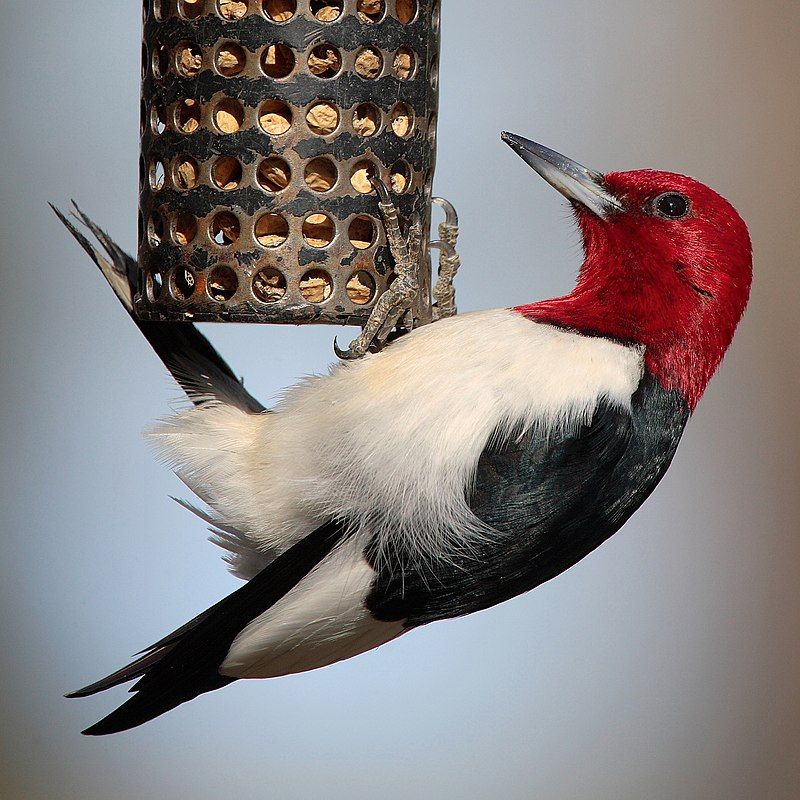
The red-headed woodpecker is a type of woodpecker found in temperate North America. It is a mid-sized bird with a length ranging from 29 to 33 cm. This bird has a prominent red head, white neck, and black body. Its wings are black and white with some white barring.
Its tail is black with white barring. The red-headed woodpecker is a migratory bird, typically breeding in open country across southern Canada and the east-central United States. It prefers open habitats such as field edges, orchards, and stands of dead trees.
Its diet consists mainly of insects and some fruits and nuts. It will also visit bird feeders for food. The red-headed woodpecker is an essential bird for wooded ecosystems.
Its presence indicates a healthy environment, as the bird is known to excavate cavities in dead trees for nesting.
These cavities create nesting and roosting sites for other birds and small animals, which helps maintain the ecosystem’s natural balance. The red-headed woodpecker is considered a species of Concern due to a rapid population decline in recent years.
This decline is linked to various factors, including habitat destruction, competition from other species, and pesticide use. Conservation measures have been implemented to protect this species, such as habitat restoration and protection of existing nesting sites.
| Kingdom | Animalia |
| Phylum | Chordata |
| Class | Aves |
| Order | Piciformes |
| Family | Picidae |
| Genus | Melanerpes |
| Species | M. erythrocephalus |
6. Red-Bellied Woodpecker
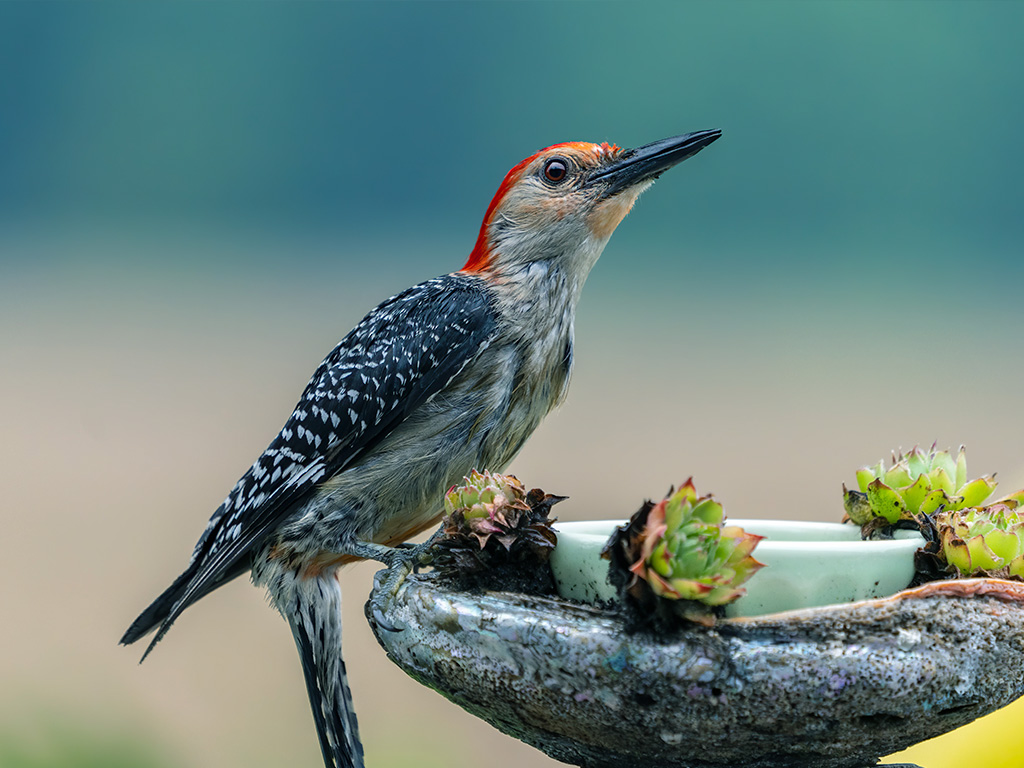
The red-bellied woodpecker is a bird of the Picidae family and is considered to be of medium size. It can be found in various habitats, from forests to parks, and has a wide distribution range in the eastern United States.
It is found as far south as Florida and north as Canada. This woodpecker species is known for its distinctive red belly, which can be seen when perched on a tree.
Its diet consists mainly of insects, which it obtains by pecking into wood and eating fruits, nuts, and seeds. The red-bellied woodpecker is an essential species in the United States and is an integral part of the local ecology.
| Kingdom | Animalia |
| Phylum | Chordata |
| Class | Aves |
| Order | Piciformes |
| Family | Picidae |
| Genus | Melanerpes |
| Species | M. carolinus |
7. American Robin
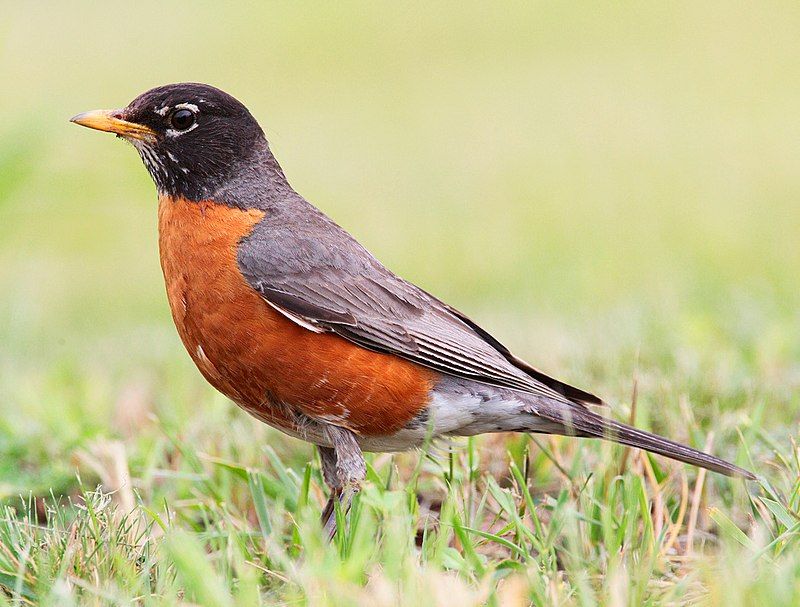
The American robin is a migratory bird that belongs to the valid thrush genus and the wider thrush family called Turdidae. It has been named after the European robin due to its reddish-orange breast, which is similar in color to the European robin.
However, the two species are not closely related as the European robin is part of the Old World flycatcher family. The American robin is mainly found in North America and is a famous garden bird. It is a large bird with a grey back, black head, and a light brown breast.
Its diet consists of insects, fruits, and berries. It is a migratory bird and typically migrates to the southern United States and Mexico in the winter. It is a beneficial bird as it helps rid gardens of insects and grubs.
| Kingdom | Animalia |
| Phylum | Chordata |
| Class | Aves |
| Order | Passeriformes |
| Family | Turdidae |
| Genus | Turdus |
| Species | T. migratorius |
8. Painted Bunting
The painted bunting is a species of bird that is part of the Cardinalidae family. It is a native species to North America and can be seen in many regions. The male-painted buntings are particularly striking due to their bright and colorful plumage.
However, this is not seen until the second year of life. Before this, the males can only be distinguished from females through close inspection. This is done by looking for slight differences in color, pattern, and size.
The females are generally paler and less colorful than the males. In both cases, the birds can be identified by their short, stubby beaks and round heads. The painted bunting is an essential species for North America and is often sought after by bird watchers.
Their bright colors are a welcome sight in many different habitats, and they are known to feed on insects, seeds, and fruits. Unfortunately, their populations are declining due to habitat loss and other human-induced changes.
Conservation efforts have been made to protect this species, and we must continue.
| Kingdom | Animalia |
| Phylum | Chordata |
| Class | Aves |
| Order | Passeriformes |
| Family | Cardinalidae |
| Genus | Passerina |
| Species | P. ciris |
9. Red Crossbill
The red crossbill is a small bird in the finch family Fringillidae. It is also known as the common crossbill. These birds are characterized by their distinctive curved mandibles crossed at the tips.
This adaptation allows them to efficiently extract seeds from conifer cones and other fruits. This unique feature enables the red crossbill to survive in colder climates, as the conifer cones provide an essential food source even in winter.
The red crossbill can also eat various other fruits, such as berries, though it mainly feeds on the seeds from conifer cones.
The red crossbill is a hardy species found in many countries throughout the northern hemisphere, and its population is considered stable.
| Kingdom | Animalia |
| Phylum | Chordata |
| Class | Aves |
| Order | Passeriformes |
| Family | Fringillidae |
| Genus | Loxia |
| Species | L. curvirostra |
10. Two-Barred Crossbill
The two-barred crossbill, also known as the white-winged crossbill, is a species of bird that is part of the finch family Fringillidae. It is pretty small in size and is generally found in coniferous forests found in both North America and the Palearctic.
The two-barred crossbill is distinctive, with a large, thick bill curved slightly at the end and two black bars at the top and bottom of its wings. They are typically gray, with a white underside and white on the tips of their wings.
Its short tail and relatively long legs make it well-suited for hopping through the trees. The two-barred crossbill primarily feeds on seeds and cones from coniferous trees. They also eat other small insects, such as spiders, caterpillars, and beetles.
They use their curved beaks to pry open the cones and extract the seeds on which they feed. During the summer, the two-barred crossbill breeds in North America and the Palearctic.
They typically nest in coniferous trees, with the female laying up to four eggs in a clutch. The female incubates the eggs for about two weeks, and the young hatchlings fledge after about three weeks.
The two-barred crossbill is a bird species in North America and the Palearctic. They are small passerines that are gray, with two black bars on their wings and a large, curved bill.
They feed on seeds and cones from coniferous trees and breed during summer.
| Kingdom | Animalia |
| Phylum | Chordata |
| Class | Aves |
| Order | Passeriformes |
| Family | Fringillidae |
| Genus | Loxia |
| Species | L. leucoptera |
11. Common Redpoll
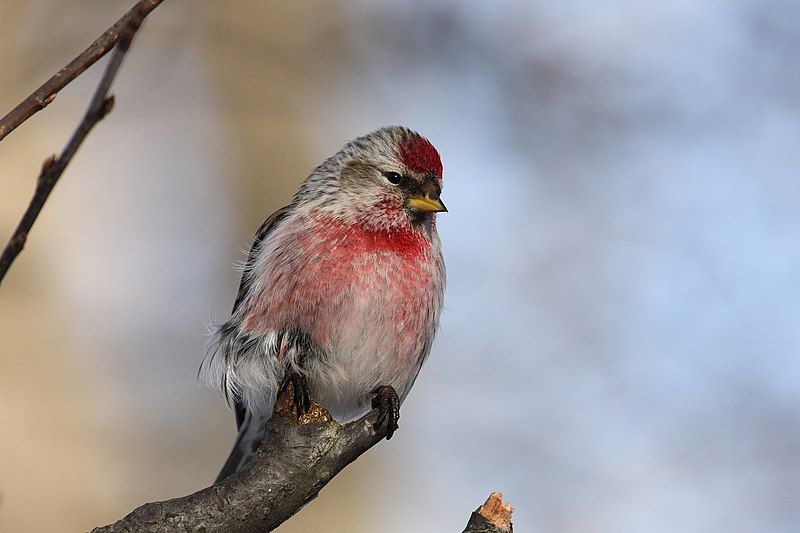
The common redpoll or mealy redpoll is a bird species in the finch family. It is a small, sparrow-like bird found in the northern parts of the Northern Hemisphere. The common redpoll is mainly known for its bright red cap and yellow breast.
It usually feeds on the seeds of trees and shrubs and sometimes on insects. The common redpoll breeds further south than the Arctic redpoll, with habitats that include thickets or shrubs. They prefer dense thickets that provide shelter from predators and the elements.
These thickets also contain many of the food sources that the birds need.
The common redpoll may also be found in open areas, such as farmland, but will still choose areas with thicker vegetation to nest in. The common redpoll has a wide variety of calls, which include a high-pitched “wee-sew” or a softer “se-se-se.”
Its song is quite varied and includes a mix of trills and chirps. They are also known to sing duets with each other. The common redpoll is a social bird, and they can often be seen in flocks.
They are often found in flocks with other species of finches, such as the yellowhammer and the linnet. During the winter, they form large flocks of up to several hundred birds.
These flocks may also include the Arctic redpoll. The common redpoll is a species of bird in the finch family. It breeds further south than the Arctic redpoll and prefers habitats with thickets or shrubs.
It is a social bird that can often be seen in large flocks and has various calls. The common redpoll is easily recognizable thanks to its bright red cap and yellow breast.
| Kingdom | Animalia |
| Phylum | Chordata |
| Class | Aves |
| Order | Passeriformes |
| Family | Fringillidae |
| Genus | Acanthis |
| Species | A. flammea |
12. Pileated Woodpecker
The pileated woodpecker is a large bird native to North America. It is primarily black and is easily recognizable by its red crest and white stripes on its face. This woodpecker species is an insectivore, meaning it feeds mainly on insects.
It can be found in deciduous forests throughout much of eastern North America, the Great Lakes region, the boreal forests of Canada, and parts of the Pacific Coast.
The pileated woodpecker is an essential species for the health of the forest, as it helps to control pests and create homes for other wildlife by creating cavities in trees.
The destruction of its habitat has led to a decline in its population, which is why conservation efforts are crucial for survival.
| Kingdom | Animalia |
| Phylum | Chordata |
| Class | Aves |
| Order | Piciformes |
| Family | Picidae |
| Genus | Dryocopus |
| Species | D. pileatus |
13. Ruby-Throated Hummingbird
The ruby-throated hummingbird is a species of hummingbird found throughout North America. This species can be found in warm climates such as Central America, Mexico, and Florida during the winter, where temperatures are mild enough to sustain their needs.
However, they migrate to more temperate regions in Canada and other parts of Eastern North America in summertime, as this is the ideal location for them to breed.
The ruby-throated hummingbird is adapted to withstand long-distance migrations, which they undertake every year to ensure their species’ survival. During these migrations, they can travel up to 500 miles in a single day and cover up to 2,000 miles.
These remarkable journeys help the ruby-throated hummingbird to reach the ideal breeding grounds and to ensure their population remains healthy.
| Kingdom | Animalia |
| Phylum | Chordata |
| Class | Aves |
| Clade | Strisores |
| Order | Apodiformes |
| Family | Trochilidae |
| Genus | Archilochus |
| Species | A. colubris |
14. Eastern Towhee
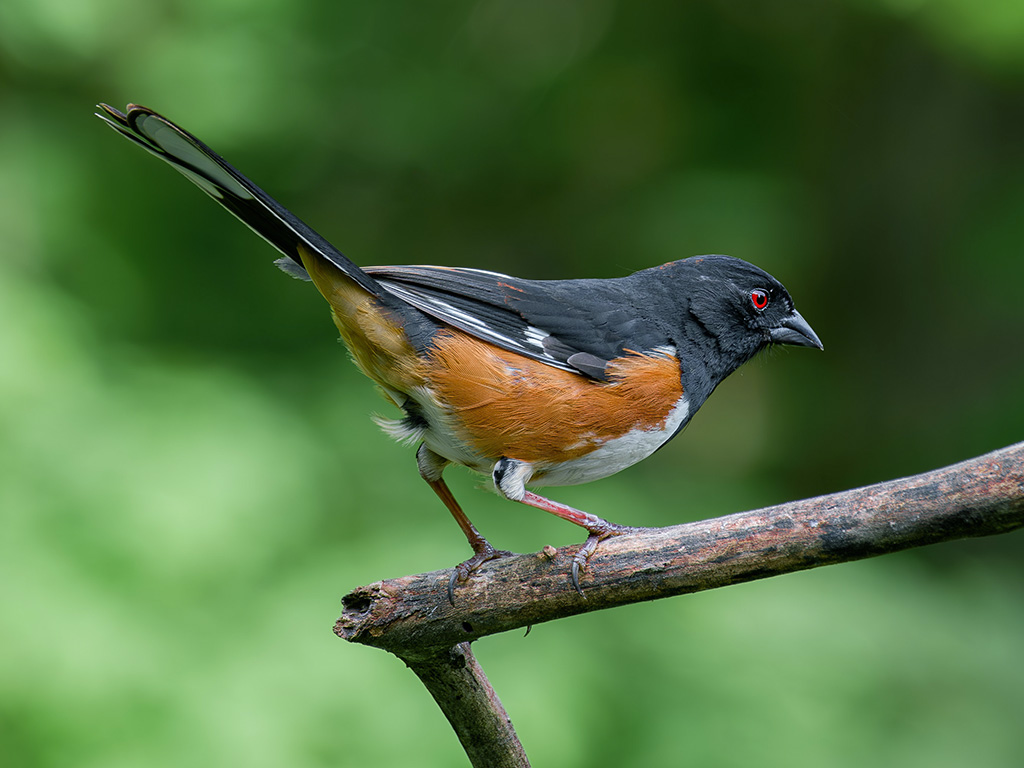
The Eastern Towhee is a large species of sparrow native to North America. It is closely related to the Spotted Towhee, and until recently, it was thought that these two birds were part of the same species, known as the Rufous-Sided Towhee.
The Eastern Towhee breeds in various habitats, including thick brush and shrubbery throughout the eastern parts of North America. The Eastern Towhee is usually found in thickets, woodlands, and hedgerows and is known for its loud, ringing call.
This bird has been the subject of much debate in recent decades, with some researchers suggesting that the Eastern Towhee and the Spotted Towhee should be treated as separate species.
This debate continues, but many now accept that the two birds are distinct species. The Eastern Towhee is a beautiful bird with a reddish-brown back, white underparts, and a black head with a distinctive white-striped pattern.
They also have bright yellow eyes and can be heard singing various melodic songs. These birds feed on multiple insects, seeds, fruits, and other small invertebrates. The Eastern Towhee is an essential bird in North America and is a valuable part of the ecosystem.
They provide food for various predators, and their presence can signify a healthy environment. This species is currently listed as Least Concern by the IUCN Red List, and its population is considered stable.
| Kingdom | Animalia |
| Phylum | Chordata |
| Class | Aves |
| Order | Passeriformes |
| Family | Passerellidae |
| Genus | Pipilo |
| Species | P. erythrophthalmus |
15. Northern Flicker
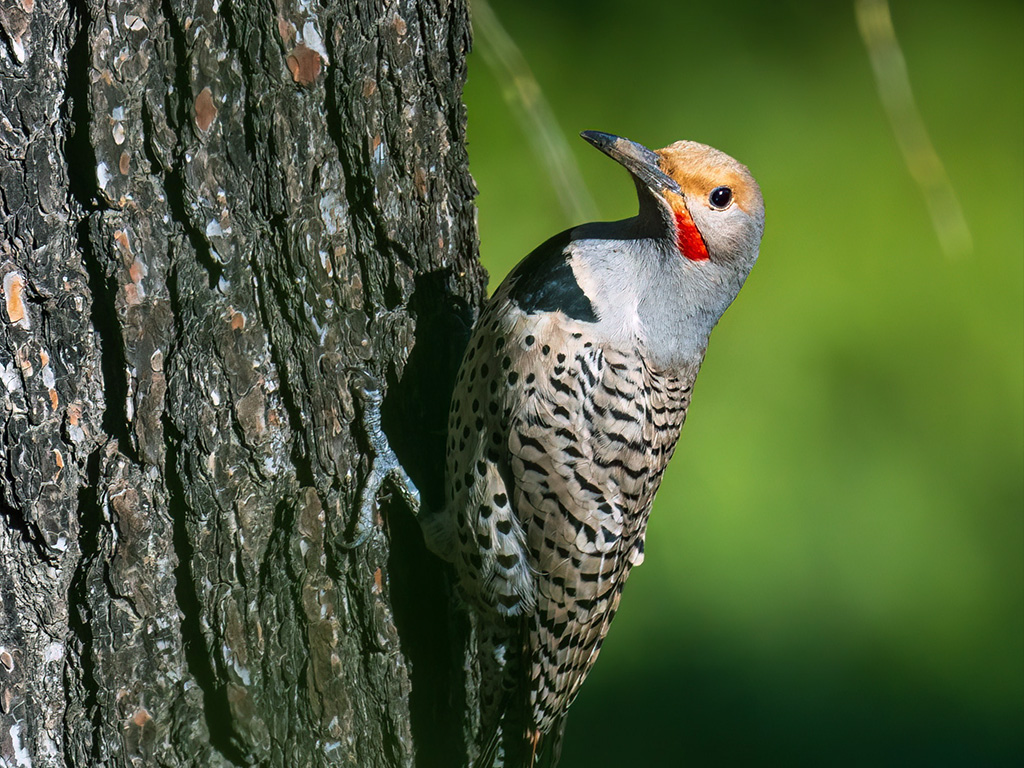
The northern flicker, also known as the familiar flicker, is a species of bird that belongs to the woodpecker family. This species is native to most of North America and Central America, Cuba, and the Cayman Islands.
It is a medium-sized bird, typically roughly 10 to 15 inches long, with distinct brown, black, and white markings. The northern flicker is also unique in that it is one of the few woodpecker species that migrate.
These birds travel south during the fall and winter months, searching for warmer climates and more abundant food sources. They may travel as far as Central America or even Cuba to survive the northern regions’ colder temperatures.
| Kingdom | Animalia |
| Phylum | Chordata |
| Class | Aves |
| Order | Piciformes |
| Family | Picidae |
| Genus | Colaptes |
| Species | C. auratus |
16. Palm Warbler
The palm warbler is a small, attractive songbird that belongs to the New World warbler family. These birds are typically found in North American habitats such as wetlands, woodlands, and brushlands.
They have a distinct yellow breast, grayish-brown upperparts, and a white belly. They also have a unique, bright yellow patch near their eyes. Palm warblers can make various melodic sounds and are known for their ability to sing even during migration.
They often flock together in large numbers to feed and travel. In the winter, they migrate south to warmer climates, while in the summer, they migrate north to breed. Palm warblers mostly eat insects and spiders but will also eat fruits and berries.
They are highly active birds and can be seen foraging for food on the ground or in the trees. The palm warbler is a beautiful bird and a valuable part of the North American ecosystem.
Its presence is a reminder of the importance of preserving and protecting natural habitats.
| Kingdom | Animalia |
| Phylum | Chordata |
| Class | Aves |
| Order | Passeriformes |
| Family | Parulidae |
| Genus | Setophaga |
| Species | S. palmarum |
17. Downy Woodpecker
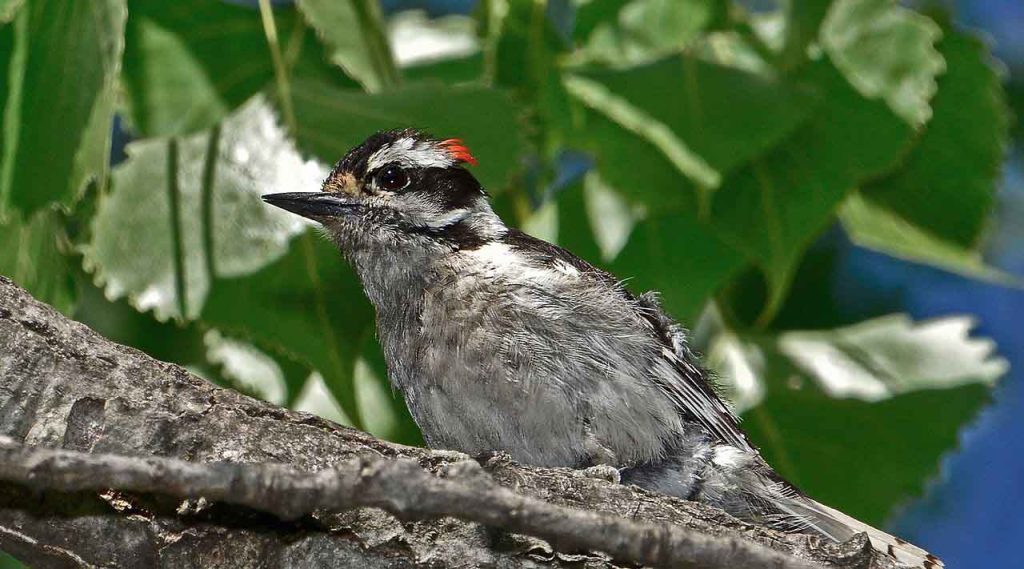
The downy woodpecker is a species found in North America and is the smallest. It can grow to be between 14 and 18 centimeters in length.
Its natural habitat is mainly forested areas in the United States and Canada, except for the deserts of the southwestern United States and the northern tundra regions. Downy woodpeckers typically feed on insects, larvae, and nuts.
They use their strong beaks to hammer into the bark of trees and dig into the wood to search for food. They also create cavities in trees to make nests and store food for the winter months. They are also known to use their beaks to communicate with other woodpeckers.
The downy woodpecker is an integral part of many ecosystems, providing food for other animals and helping to maintain healthy tree populations. It is also a famous bird with birdwatchers due to its beautiful, unique pattern and wide range.
Several conservation efforts are underway to help protect and maintain the population of downy woodpeckers, as well as to help ensure their habitats remain healthy and productive.
| Kingdom | Animalia |
| Phylum | Chordata |
| Class | Aves |
| Order | Piciformes |
| Family | Picidae |
| Genus | Dryobates |
| Species | D. pubescens |
18. Red-Cockaded Woodpecker
The red-cockaded woodpecker is a woodpecker species native to the southeastern United States. This species is unique in that it is the only woodpecker in its range that excavates its nesting cavities in living pine trees.
The red-cockaded woodpecker is a small bird, measuring six to seven inches long and weighing roughly one-third an ounce. Its back is black and white, while its wings and tail are black.
Its breast and belly are white, with a distinctive band of black feathers around its neck. The red-cockaded woodpecker is a very social bird, living in family groups of up to eight individuals.
These small groups inhabit territories that can range in size from five to twenty-five acres. The red-cockaded woodpecker is an endangered species due mainly to habitat loss from logging, development, and fire suppression.
Conservation efforts have helped to stabilize the population, but this species remains vulnerable.
| Kingdom | Animalia |
| Phylum | Chordata |
| Class | Aves |
| Order | Piciformes |
| Family | Picidae |
| Genus | Leuconotopicus |
| Species | L. borealis |
19. Red-Winged Blackbird
The red-winged blackbird is a type of bird belonging to the family Icteridae. It is found in most parts of North America and a large part of Central America. This bird has a distinct black body with bright red and yellow colored wings.
They are known to make a loud, melodic call, which is quite recognizable. This bird’s preferred habitat includes open wetlands, grassy fields, meadows, and marshes.
They often nest in tall grasses and shrubs. The red-winged blackbird is a migratory species and can be spotted across various habitats. During the breeding season, they live in groups and form huge colonies.
These colonies are often found close to the water and can be significant. The red-winged blackbird’s diet consists mainly of insects, seeds, and berries. In addition to its colorful wings and loud call, the red-winged blackbird is also quite territorial.
During the breeding season, males can be seen defending their territories against other birds. During winter, they often form flocks and migrate to warmer climates. The red-winged blackbird is a beautiful bird seen in many parts of the world.
Its bright colors and loud call make it a memorable sight and sound in the wild.
| Kingdom | Animalia |
| Phylum | Chordata |
| Class | Aves |
| Order | Passeriformes |
| Family | Icteridae |
| Genus | Agelaius |
| Species | A. phoeniceus |
20. Buff-Bellied Hummingbird
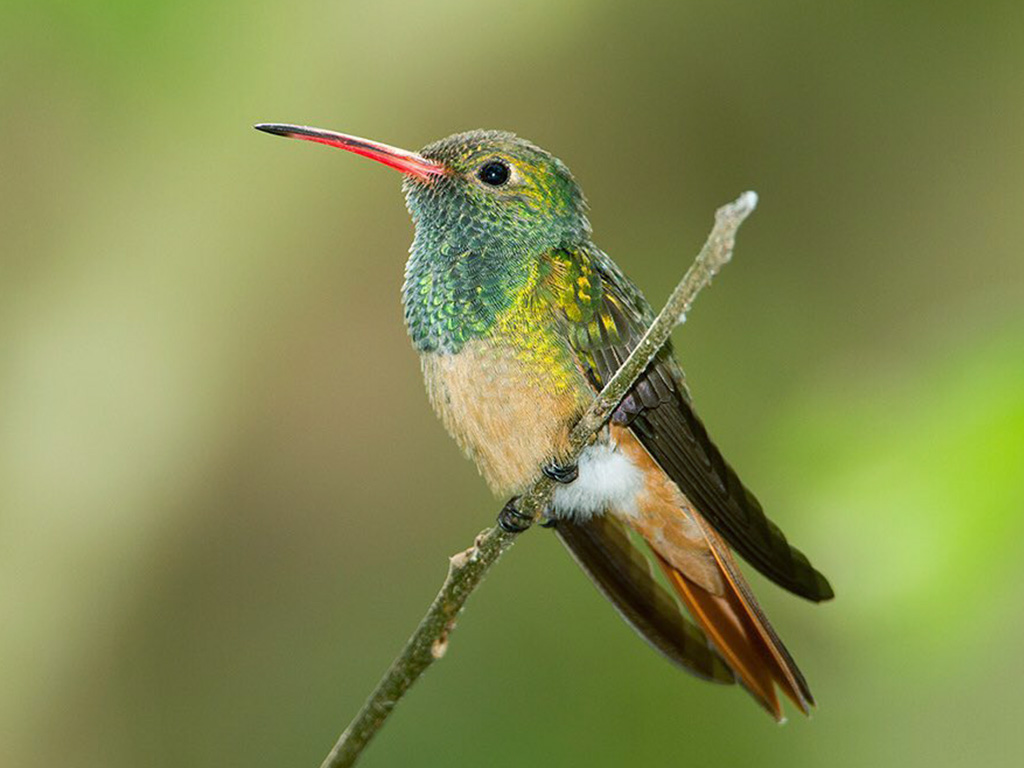
The Buff-bellied Hummingbird is a hummingbird species in the Trochilini’ emeralds’ tribe. A subfamily of Trochilinae, it is native to Belize, Guatemala, Mexico, and the United States. It is a medium-sized hummingbird, usually measuring around 4 inches in length.
It has a greenish-black head, a white throat, and an iridescent, buff-colored belly. The wings are dark brown, and the tail is deeply forked. The Buff-bellied Hummingbird is a migratory species typically found in tropical and subtropical regions.
It is a nectar feeder usually spotted in gardens or near flowering shrubs and trees. Its diet consists mainly of nectar, but it also feeds on small insects and spiders. The Buff-bellied Hummingbird is a social species often seen in large groups.
It is an acrobatic flyer that can hover in mid-air while feeding on nectar from flowers.
It is also known to defend its territory aggressively and will chase away other hummingbirds that enter its space. The Buff-bellied Hummingbird is a vital pollinator, as it helps to spread pollen from one flower to another while it feeds.
It is also an essential part of the biodiversity of the regions where it is found and plays a vital role in the local ecosystem.
| Kingdom | Animalia |
| Phylum | Chordata |
| Class | Aves |
| Clade | Strisores |
| Order | Apodiformes |
| Family | Trochilidae |
| Genus | Amazilia |
| Species | A. yucatanensis |
21. Oystercatchers
Oystercatchers are a family of wading birds, classified as Haematopodidae, with only one genus, Haematopus. They can be seen on most coasts worldwide, except the polar regions and some areas of Africa and South East Asia.
Oystercatchers have various habitats, from salt marshes and estuaries to sandy beaches and mudflats. They are renowned for their loud calls, which can be heard long distances.
They mainly feed on mollusks, such as mussels, oysters, and clams, and can use their long, bright red beaks to pry open the shells. Oystercatchers are also known for their ability to detect the presence of hidden prey by their calls and movements.
They have a unique breeding behavior, forming monogamous pairs that stay together for the breeding season. The female lays two or three eggs in a nest made in a scrape on the ground. The eggs are then incubated for 24-30 days, with both parents taking turns.
The young chicks can leave the nest and feed themselves soon after hatching.
| Kingdom | Animalia |
| Phylum | Chordata |
| Class | Aves |
| Order | Charadriiformes |
| Family | Haematopodidae |
| Genus | Haematopus |
Conclusion
Redbirds are a common sight in South Carolina. While they may not be as numerous as other species of birds, they can be seen in the state throughout the year. Their stunning red plumage and melodious songs make them a delight to observe.
With the proper habitat, red birds can be easily attracted to any area in South Carolina.